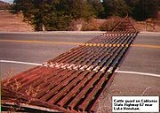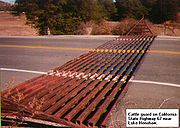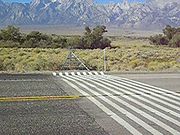
Cattle grid
Encyclopedia
A cattle grid(British English
) or cattle guard (American English
) – also known as a vehicle pass, Texas gate, stock gap (in U.S. Southeast
) or, in New Zealand
, a cattle stop – is a type of obstacle used to prevent livestock
, such as sheep, cattle
, pigs
, horse
s, or mule
s from passing along a road or railway which penetrates the fencing surrounding an enclosed piece of land. It consists of a depression in the road covered by a transverse grid of bars or tubes, normally made of metal and firmly fixed to the ground on either side of the depression, such that the gaps between them are wide enough for animal
s' legs to pass through, but sufficiently narrow not to impede a wheeled vehicle or plantigrade
foot. They rely for their effect (of barring passage to animals but not to wheeled vehicles) upon animals' reluctance to set foot upon them.
 Cattle grids are usually installed on roads where they cross a fence
Cattle grids are usually installed on roads where they cross a fence
line, often at a boundary between public and private lands. They are an alternative to the erection of gates that would need to be opened and closed every time a vehicle passed, and are common where roads cross open moorland
, rangeland
or common land
maintained by grazing, but where segregation of fields is impractical. Cattle grids are also used when otherwise unfenced railways cross a fenceline. Cattle grids are seen throughout the world and quite common in places such as Australia
, the Scottish Highlands
, or the National Parks of England and Wales
. They are also common throughout the Western United States
and Canada
, where they are usually called a cattle guard or, occasionally, a Texas gate. In the USA, they are most often used on BLM
and Forest Service
land, but are also used on paved roads and even exit ramps of the Interstate Highway System
in many rural areas.
 While these barriers are usually effective, they can fail due to ingenious animals. Sheep have been known to jump or run along the side of grids as wide as 8 feet (2.4 m), traversing them to find more and better food or water. Wider grids are used where deer are to be contained. Some animals, particularly wildlife, can jump across them, and animals with particularly large feet, such as American bison
While these barriers are usually effective, they can fail due to ingenious animals. Sheep have been known to jump or run along the side of grids as wide as 8 feet (2.4 m), traversing them to find more and better food or water. Wider grids are used where deer are to be contained. Some animals, particularly wildlife, can jump across them, and animals with particularly large feet, such as American bison
or even particularly large bovine bulls
, can walk across them without slipping between the bars. Sometimes, they may be connected to an electric fence to prevent predatory animals, such as dingo
es and fox
es walking over them. In areas with heavy snowfall and long periods without a thaw, snow can pile up under a grid and allow animals to walk across it.
 Portable "Texas gates" suspend the gate by springs so that it lowers to the ground when a vehicle passes over then returns to a position 6 inches (15 cm) above the ground.
Portable "Texas gates" suspend the gate by springs so that it lowers to the ground when a vehicle passes over then returns to a position 6 inches (15 cm) above the ground.
Painted lines on the road can serve as skeuomorph
s of cattle grids. The light-dark pattern of lines and pavement resembles a true cattle guard to animals. Many animals see a more intense contrast between light and dark because their night vision is much better than humans'. Animals see the sharp contrast of the cattle guard on the ground as a false visual cliff; they act as if the dark parts are deeper than the light parts. Using a virtual cattle guard is cheaper than a true cattle guard, and can be used on higher-speed roads due to its smooth surface.
"Electric cattle guards" use electricity to deter animals from crossing the fence line. The cattle guard is composed of a bi-layer rubber polymer that lays directly on ground. The lower layer insulates electricity from ground and the upper layer carries an electric voltage which shocks any animal that touches the cattle guard and ground at the same time. The rubber polymer allows wheeled traffic to cross.
(US PTO) issued patent # 1,125,095 dated 15 January 1915 to William J. Hickey, Reno, Nevada.
There is a British Standard for cattle grids: BS4008:2006. The US standards are put forth by The American Association of State Highway and Transportation Officials
(AASHTO). AASHTO provides load rating guidelines for cattle guards that are used on public roads in America. All cattle guards used on American public roads must be certified by a qualified engineer that the guard meets AASHTO guidelines.
British English
British English, or English , is the broad term used to distinguish the forms of the English language used in the United Kingdom from forms used elsewhere...
) or cattle guard (American English
American English
American English is a set of dialects of the English language used mostly in the United States. Approximately two-thirds of the world's native speakers of English live in the United States....
) – also known as a vehicle pass, Texas gate, stock gap (in U.S. Southeast
) or, in New Zealand
New Zealand
New Zealand is an island country in the south-western Pacific Ocean comprising two main landmasses and numerous smaller islands. The country is situated some east of Australia across the Tasman Sea, and roughly south of the Pacific island nations of New Caledonia, Fiji, and Tonga...
, a cattle stop – is a type of obstacle used to prevent livestock
Livestock
Livestock refers to one or more domesticated animals raised in an agricultural setting to produce commodities such as food, fiber and labor. The term "livestock" as used in this article does not include poultry or farmed fish; however the inclusion of these, especially poultry, within the meaning...
, such as sheep, cattle
Cattle
Cattle are the most common type of large domesticated ungulates. They are a prominent modern member of the subfamily Bovinae, are the most widespread species of the genus Bos, and are most commonly classified collectively as Bos primigenius...
, pigs
Domestic pig
The domestic pig is a domesticated animal that traces its ancestry to the wild boar, and is considered a subspecies of the wild boar or a distinct species in its own right. It is likely the wild boar was domesticated as early as 13,000 BC in the Tigris River basin...
, horse
Horse
The horse is one of two extant subspecies of Equus ferus, or the wild horse. It is a single-hooved mammal belonging to the taxonomic family Equidae. The horse has evolved over the past 45 to 55 million years from a small multi-toed creature into the large, single-toed animal of today...
s, or mule
Mule
A mule is the offspring of a male donkey and a female horse. Horses and donkeys are different species, with different numbers of chromosomes. Of the two F1 hybrids between these two species, a mule is easier to obtain than a hinny...
s from passing along a road or railway which penetrates the fencing surrounding an enclosed piece of land. It consists of a depression in the road covered by a transverse grid of bars or tubes, normally made of metal and firmly fixed to the ground on either side of the depression, such that the gaps between them are wide enough for animal
Animal
Animals are a major group of multicellular, eukaryotic organisms of the kingdom Animalia or Metazoa. Their body plan eventually becomes fixed as they develop, although some undergo a process of metamorphosis later on in their life. Most animals are motile, meaning they can move spontaneously and...
s' legs to pass through, but sufficiently narrow not to impede a wheeled vehicle or plantigrade
Plantigrade
right|151px|thumb|Human skeleton, showing plantigrade habitIn terrestrial animals, plantigrade locomotion means walking with the podials and metatarsals flat on the ground. It is one of three forms of locomotion adopted by mammals...
foot. They rely for their effect (of barring passage to animals but not to wheeled vehicles) upon animals' reluctance to set foot upon them.

Fence
A fence is a freestanding structure designed to restrict or prevent movement across a boundary. It is generally distinguished from a wall by the lightness of its construction: a wall is usually restricted to such barriers made from solid brick or concrete, blocking vision as well as passage .Fences...
line, often at a boundary between public and private lands. They are an alternative to the erection of gates that would need to be opened and closed every time a vehicle passed, and are common where roads cross open moorland
Moorland
Moorland or moor is a type of habitat, in the temperate grasslands, savannas, and shrublands biome, found in upland areas, characterised by low-growing vegetation on acidic soils and heavy fog...
, rangeland
Rangeland
Rangelands are vast natural landscapes in the form of grasslands, shrublands, woodlands, wetlands, and deserts. Types of rangelands include tallgrass and shortgrass prairies, desert grasslands and shrublands, woodlands, savannas, chaparrals, steppes, and tundras...
or common land
Common land
Common land is land owned collectively or by one person, but over which other people have certain traditional rights, such as to allow their livestock to graze upon it, to collect firewood, or to cut turf for fuel...
maintained by grazing, but where segregation of fields is impractical. Cattle grids are also used when otherwise unfenced railways cross a fenceline. Cattle grids are seen throughout the world and quite common in places such as Australia
Australia
Australia , officially the Commonwealth of Australia, is a country in the Southern Hemisphere comprising the mainland of the Australian continent, the island of Tasmania, and numerous smaller islands in the Indian and Pacific Oceans. It is the world's sixth-largest country by total area...
, the Scottish Highlands
Scottish Highlands
The Highlands is an historic region of Scotland. The area is sometimes referred to as the "Scottish Highlands". It was culturally distinguishable from the Lowlands from the later Middle Ages into the modern period, when Lowland Scots replaced Scottish Gaelic throughout most of the Lowlands...
, or the National Parks of England and Wales
National parks of England and Wales
The national parks of England and Wales are areas of relatively undeveloped and scenic landscape that are designated under the National Parks and Access to the Countryside Act 1949...
. They are also common throughout the Western United States
United States
The United States of America is a federal constitutional republic comprising fifty states and a federal district...
and Canada
Canada
Canada is a North American country consisting of ten provinces and three territories. Located in the northern part of the continent, it extends from the Atlantic Ocean in the east to the Pacific Ocean in the west, and northward into the Arctic Ocean...
, where they are usually called a cattle guard or, occasionally, a Texas gate. In the USA, they are most often used on BLM
Bureau of Land Management
The Bureau of Land Management is an agency within the United States Department of the Interior which administers America's public lands, totaling approximately , or one-eighth of the landmass of the country. The BLM also manages of subsurface mineral estate underlying federal, state and private...
and Forest Service
United States Forest Service
The United States Forest Service is an agency of the United States Department of Agriculture that administers the nation's 155 national forests and 20 national grasslands, which encompass...
land, but are also used on paved roads and even exit ramps of the Interstate Highway System
Interstate Highway System
The Dwight D. Eisenhower National System of Interstate and Defense Highways, , is a network of limited-access roads including freeways, highways, and expressways forming part of the National Highway System of the United States of America...
in many rural areas.

American Bison
The American bison , also commonly known as the American buffalo, is a North American species of bison that once roamed the grasslands of North America in massive herds...
or even particularly large bovine bulls
Cattle
Cattle are the most common type of large domesticated ungulates. They are a prominent modern member of the subfamily Bovinae, are the most widespread species of the genus Bos, and are most commonly classified collectively as Bos primigenius...
, can walk across them without slipping between the bars. Sometimes, they may be connected to an electric fence to prevent predatory animals, such as dingo
Dingo
The Australian Dingo or Warrigal is a free-roaming wild dog unique to the continent of Australia, mainly found in the outback. Its original ancestors are thought to have arrived with humans from southeast Asia thousands of years ago, when dogs were still relatively undomesticated and closer to...
es and fox
Fox
Fox is a common name for many species of omnivorous mammals belonging to the Canidae family. Foxes are small to medium-sized canids , characterized by possessing a long narrow snout, and a bushy tail .Members of about 37 species are referred to as foxes, of which only 12 species actually belong to...
es walking over them. In areas with heavy snowfall and long periods without a thaw, snow can pile up under a grid and allow animals to walk across it.

Painted lines on the road can serve as skeuomorph
Skeuomorph
A skeuomorph , or skeuomorphism ,is a derivative object that retains ornamental design cues to a structure that was necessary in the original...
s of cattle grids. The light-dark pattern of lines and pavement resembles a true cattle guard to animals. Many animals see a more intense contrast between light and dark because their night vision is much better than humans'. Animals see the sharp contrast of the cattle guard on the ground as a false visual cliff; they act as if the dark parts are deeper than the light parts. Using a virtual cattle guard is cheaper than a true cattle guard, and can be used on higher-speed roads due to its smooth surface.
"Electric cattle guards" use electricity to deter animals from crossing the fence line. The cattle guard is composed of a bi-layer rubber polymer that lays directly on ground. The lower layer insulates electricity from ground and the upper layer carries an electric voltage which shocks any animal that touches the cattle guard and ground at the same time. The rubber polymer allows wheeled traffic to cross.
Patents and Standards
The United States Patent and Trademark OfficeUnited States Patent and Trademark Office
The United States Patent and Trademark Office is an agency in the United States Department of Commerce that issues patents to inventors and businesses for their inventions, and trademark registration for product and intellectual property identification.The USPTO is based in Alexandria, Virginia,...
(US PTO) issued patent # 1,125,095 dated 15 January 1915 to William J. Hickey, Reno, Nevada.
There is a British Standard for cattle grids: BS4008:2006. The US standards are put forth by The American Association of State Highway and Transportation Officials
American Association of State Highway and Transportation Officials
AASHTO, the American Association of State Highway and Transportation Officials, is a standards setting body which publishes specifications, test protocols and guidelines which are used in highway design and construction throughout the United States...
(AASHTO). AASHTO provides load rating guidelines for cattle guards that are used on public roads in America. All cattle guards used on American public roads must be certified by a qualified engineer that the guard meets AASHTO guidelines.

